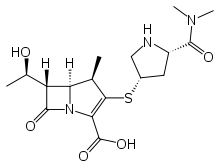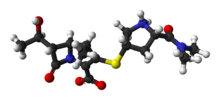Meropenem
 | |
 | |
| Clinical data | |
|---|---|
| Trade names | Merrem, others |
| AHFS/Drugs.com | Monograph |
| Pregnancy category |
|
| Routes of administration | Intravenous |
| ATC code | |
| Legal status | |
| Legal status | |
| Pharmacokinetic data | |
| Bioavailability | 100% |
| Protein binding | Approximately 2% |
| Biological half-life | 1 hour |
| Excretion | Renal |
| Identifiers | |
| |
| CAS Number | |
| PubChem CID | |
| DrugBank | |
| ChemSpider | |
| UNII | |
| KEGG | |
| ChEBI | |
| ChEMBL | |
| ECHA InfoCard | 100.170.691 |
| Chemical and physical data | |
| Formula | C17H25N3O5S |
| Molar mass | 383.464 g/mol |
| 3D model (JSmol) | |
| |
| |
| (verify) | |
Meropenem, sold under the brandname Merrem among others, is an broad-spectrum antibiotic used to treat a wide variety of infections. It is a β-lactam and belongs to the subgroup of carbapenems, similar to imipenem and ertapenem.
Meropenem was developed by Dainippon Sumitomo Pharma and patented in 1983.[1][2][3] It gained US FDA approval in July 1996. It penetrates well into many tissues and body fluids, including cerebrospinal fluid, bile, heart valve, lung, and peritoneal fluid.[4] It was initially marketed by AstraZeneca. It is on the World Health Organization's List of Essential Medicines, the most effective and safe medicines needed in a health system.[5]
Medical uses
The spectrum of action includes many Gram-positive and Gram-negative bacteria (including Pseudomonas) and anaerobic bacteria. The overall spectrum is similar to that of imipenem, although meropenem is more active against Enterobacteriaceae and less active against Gram-positive bacteria. It works against extended-spectrum β-lactamases, but may be more susceptible to metallo-β-lactamases.[4] Meropenem is frequently given in the treatment of febrile neutropenia. This condition frequently occurs in patients with hematological malignancies and cancer patients receiving anticancer drugs that suppress bone marrow formation. It is approved for complicated skin and skin structure infections, complicated intra-abdominal infections and bacterial meningitis.
Administration
Meropenem is administered intravenously as a white crystalline powder to be dissolved in 5% monobasic potassium phosphate solution. Dosing must be adjusted for altered kidney function and for haemofiltration.[6]
Side effects
The most common adverse effects are diarrhea (4.8%), nausea and vomiting (3.6%), injection-site inflammation (2.4%), headache (2.3%), rash (1.9%) and thrombophlebitis (0.9%).[7] Many of these adverse effects were observed in severely ill individuals already taking many medications including vancomycin.[8][9] One study showed Clostridium difficile-associated diarrhea happened in 3.6% of meropenem patients.[10] Meropenem has a reduced potential for seizures in comparison with imipenem. Several cases of severe hypokalemia have been reported.[11][12] Meropenem, like other carbopenems, is a potent inducer of multidrug resistance in bacteria.
Pharmacology
Mechanism of action
Meropenem is bactericidal except against Listeria monocytogenes, where it is bacteriostatic. It inhibits bacterial wall synthesis like other β-lactam antibiotics. In contrast to other beta-lactams, it is highly resistant to degradation by β-lactamases or cephalosporinases. In general, resistance arises due to mutations in penicillin-binding proteins, production of metallo-β-lactamases, or resistance to diffusion across the bacterial outer membrane.[7] Unlike imipenem, it is stable to dehydropeptidase-1, so can be given without cilastatin.
In 2016 a synthetic peptide-conjugated PMO (PPMO) was found to inhibit the expression of New Delhi Metallo-beta-lactamase, an enzyme that many drug-resistant bacteria use to destroy carbapenems.[13][14]
Society and culture
Trade names
| Country | Name | Maker |
|---|---|---|
| India | Inzapenum | Dream India |
| Aurobindo Pharma | ||
| Penmer | Biocon | |
| Meronir | Nirlife | |
| Merowin | Strides Acrolab | |
| Aktimer | Aktimas Biopharmaceuticals | |
| Neopenem | Neomed | |
| Mexopen | Samarth life sciences | |
| Meropenia | SYZA Health Sciences LLP | |
| Ivpenem | Medicorp Pharmaceuticals | |
| Merofit | ||
| Lykapiper | Lyka Labs | |
| Winmero | Parabolic drugs | |
| Pharmaceuticals | ||
| Bangladesh | I-Penam | Incepta |
| Merocil | Pharmacil | |
| Indonesia | Merofen | Kalbe |
| Brazil | Zylpen | Aspen Pharma |
| Japan, Korea | Meropen | |
| Australia | Merem | |
| Taiwan | Mepem | |
| Germany | Meronem | |
| US | Meronem | AstraZeneca |
| ... | Merosan | Sanbe Farma |
| Merobat | Interbat | |
| Zwipen | ||
| Carbonem | ||
| Ronem | Opsonin Pharma, BD | |
| Neopenem | ||
| Merocon | Continental | |
| Carnem | Laderly Biotech | |
| Penro | Bosch | |
| Meroza | German Remedies | |
| Merotrol | Lupin) | |
| Meromer | Orchid Chemicals | |
| Mepenox | BioChimico | |
| Meromax | Eurofarma |
References
- ↑ Fischer, Janos; Ganellin, C. Robin (2006). Analogue-based Drug Discovery. John Wiley & Sons. p. 490. ISBN 9783527607495.
- ↑ Edwards, JR; Turner, PJ; Wannop, C; Withnell, ES; Grindey, AJ; Nairn, K (February 1989). "In vitro antibacterial activity of SM-7338, a carbapenem antibiotic with stability to dehydropeptidase I". Antimicrobial Agents and Chemotherapy. 33 (2): 215–22. PMC 171460
 . PMID 2655530. doi:10.1128/AAC.33.2.215.
. PMID 2655530. doi:10.1128/AAC.33.2.215. - ↑ "Creation of Meropen® - Story of the Creation of Pharmaceuticals - Research and Development". Sumitomo Dainippon Pharma.
- 1 2 AHFS Drug Information (2006 ed.). American Society of Health-System Pharmacists. 2006.
- ↑ "WHO Model List of Essential Medicines (20th List)" (PDF). World Health Organization. March 2017. Retrieved 29 June 2017.
- ↑ Bilgrami, I; Roberts, JA; Wallis, SC; Thomas, J; Davis, J; Fowler, S; Goldrick, PB; Lipman, J (July 2010). "Meropenem dosing in critically ill patients with sepsis receiving high-volume continuous venovenous hemofiltration". Antimicrobial Agents and Chemotherapy. 54 (7): 2974–8. PMC 2897321
 . PMID 20479205. doi:10.1128/AAC.01582-09.
. PMID 20479205. doi:10.1128/AAC.01582-09. - 1 2 Mosby's Drug Consult 2006 (16 ed.). Mosby, Inc. 2006.
- ↑ Erden, M; Gulcan, E; Bilen, A; Bilen, Y; Uyanik, A; Keles, M (7 March 2013). "Pancytopenýa and Sepsýs due to Meropenem: A Case Report" (PDF). Tropical Journal of Pharmaceutical Research. 12 (1). doi:10.4314/tjpr.v12i1.21.
- ↑ "Meropenem side effects - from FDA reports". eHealthMe.
- ↑ Yeung, EYH; Gore JG; Auersperg EV (2012). "A Retrospective Analysis of the Incidence of Clostridium Difficile Associated Diarrhea with Meropenem and Piperacillin-tazobactam" (PDF). International Journal of Collaborative Research on Internal Medicine & Public Health. 4 (8): 1567–1576.
- ↑ Margolin, L (2004). "Impaired rehabilitation secondary to muscle weakness induced by meropenem". Clinical drug investigation. 24 (1): 61–2. PMID 17516692. doi:10.2165/00044011-200424010-00008.
- ↑ Bharti, R; Gombar, S; Khanna, AK (2010). "Meropenem in critical care - uncovering the truths behind weaning failure". Journal of Anaesthesiology Clinical Pharmacology. 26 (1): 99–101.
- ↑ "New molecule knocks out superbugs' immunity to antibiotics". newatlas.com. Retrieved 2017-01-25.
- ↑ K., Sully, Erin; L., Geller, Bruce; Lixin, Li,; M., Moody, Christina; M., Bailey, Stacey; L., Moore, Amy; Michael, Wong,; Patrice, Nordmann,; M., Daly, Seth. "Peptide-conjugated phosphorodiamidate morpholino oligomer (PPMO) restores carbapenem susceptibility to NDM-1-positive pathogens in vitro and in vivo". Journal of Antimicrobial Chemotherapy. doi:10.1093/jac/dkw476/2691388/peptide-conjugated-phosphorodiamidate-morpholino.